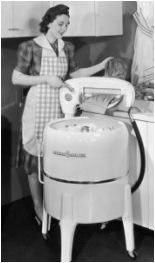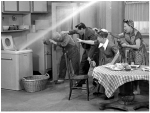
My first memory of a washing machine was the round wringer tub on my grandparents' porch. My grandfather had set up a cold water connection for the machine and made an opening from the porch to the back yard for the drainage tube. Grandmother had to boil water and add it to the tub along with Ivory Snow soap flakes or Tide detergent. This "modern" electric machine then swished and swirled the clothes, drained the water, and filled with cold rinse water. I loved being able to help roll the clothes between the two wooden rolling pins to squeeze out the excess water. This was necessary because the washer did not have a spin cycle (notice the open top.) If you put items in all bunched up or you didn't adjust the space between the rollers, you could break a button or two. We would carry the wet clothes to hang on the outdoor line in the hot Florida sunshine. The clothes smelled so fresh when we brought them in several hours later, but the towels and sheets seemed a bit stiff. We didn't have laundry softeners then and perhaps we didn't get all the soap out. Laundry took a whole days work from the washing, to waiting for the drying, to the ironing. We ironed everything including the all-cotton sheets, linen tablecloths, men's handkerchiefs (my job), and sometimes underwear.

At our house we had a more stylish washing machine with hot and cold water and a spin cycle...meaning no rollers required. The only place for it though was in our kitchen. I recall one time something clogged up the drain and the soapy water poured out all over the floor. We had quite a time trying to soak up all the water and bubbles. It was a little like an 'I Love Lucy' catastrophe.

I was often responsible to hang and bring in the clothes. Daddy cut slots in one end of long bamboo fishing poles in a way that the clotheslines could slip in. This allowed us to adjust the height of the poles, lowering the line for hanging and raising the line for drying. Sheets and long pants would drag the ground if we didn't use the poles. There were a few little hints or understood rules when hanging clothes: if you pinned the corners of two items together you could use less clothespins, but thick items needed to be hung singly or the overlapped areas would not dry as fast; sheets could be hung to dry more easily by using two lines with one side of the sheet on each line; unmentionables like underwear and bras were hung in the middle of our four lines so that the neighbors wouldn't see them.

We had a cute little clothespin bag like this that hooked over the line. It looked just like a little girls dress but there was a pouch behind the skirt. We used wooden clip pins and because they were left out in the weather they sometimes got mildew and had to be replaced.
If it rained on wash day we had to cart all the wet clothes to the laundromat to dry them. It was many years before we got a dryer that was placed on the back porch.
If it rained on wash day we had to cart all the wet clothes to the laundromat to dry them. It was many years before we got a dryer that was placed on the back porch.

Our irons were not steam irons so getting the wrinkles out required brute strength. We sprinkled the clothes with water as we ironed them using a little spray spout that was attached to an old vinegar jar. My mother hired a housekeeper for a few years, Palma Lee. She rode the bus from downtown to our house and worked on Saturdays doing the laundry and mopping the floors. I used to enjoy following her around trying to help and especially liked to be around her when she ironed. She always put a horizontal crease in the upper back of my dad's dress shirts, but I'm not sure why.

My dad wore dark green cotton uniforms to work that he liked to have ironed stiff with starch. Mother found a nifty invention called a Pant Stretcher that made ironing the pants easier. You adjusted the long rectangular wire pieces to make the frames narrower and slipped them into the wet pants, twisting and adjusting until the metal sides were where you wanted the creases, down the center front of the pants. Then you pulled the frames out to stretch the pants until they were tight as a drum and hung the whole contraption on the line. You had to do each pant leg separately. It took some time, but they did work.

I don't have many special memories about our modern laundry days. There really isn't a laundry "day" anymore as we can wash, dry, and even steam clothes at home at any time. For years we did have some type of outdoor clothes line wherever we moved, permanent or portable, but it was used less and less. I still have a German collapsible line tucked away in the garage. We have used it to make a playhouse by throwing sheets and blankets over it, or to dry large pieces of art work. Maybe sun dried some pillows, but that's about all.

There was a song, "Here We Go 'Round the Mulberry Bush" with motions that we learned long ago. It highlighted the tasks of the week, day by day. "This is the way we wash our clothes, wash our clothes, wash our clothes. This is the way we wash our clothes so early Monday morning." Tuesday was ironing, and so on. Oh, well, the times they are a'changing.
"Here's thanks to those who keep things clean, making life lovely and fit to be seen."
Do you have special laundry day memories?
"Let us draw near to God with a sincere heart and with the full assurance that faith brings,
having our hearts sprinkled to cleanse us from a guilty conscience and having our bodies
washed with pure water." Hebrews 10:22
"Here's thanks to those who keep things clean, making life lovely and fit to be seen."
Do you have special laundry day memories?
"Let us draw near to God with a sincere heart and with the full assurance that faith brings,
having our hearts sprinkled to cleanse us from a guilty conscience and having our bodies
washed with pure water." Hebrews 10:22
 RSS Feed
RSS Feed
